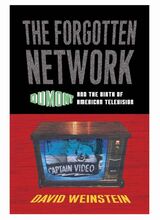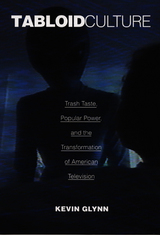5 books about American Television

The Expanding Vista
American Television in the Kennedy Years
Mary Ann Watson
Duke University Press, 1994
As American politics and television became more closely intertwined in the early 1960s, each underwent enormous and long-lasting changes. In The Expanding Vista, originally published in 1990 (Oxford University Press), Mary Ann Watson looks at how television was woven into the events and policies of John Kennedy’s presidency, not only in his unprecedented use of the medium in campaigning and image projection, but in the vigorous efforts of his administration to regulate and improve the content of network programs. Examining the legacy of the New Frontier and its relationship to the new medium, she traces the Kennedy influence across a spectrum of programming that includes news, documentary, drama, situation comedy, advertising, children’s shows, and educational TV. Through extensive archival research and oral histories Watson reconstructs key moments of an extraordinary time in the television age. The Expanding Vista’s analysis and interpretation of that era continue to enlighten our understanding of culture and communication as the themes sounded in the 1960s resonate in today’s complex media marketplace.
[more]

The Forgotten Network
DuMont and the Birth of American Television
David Weinstein
Temple University Press, 2006
During the late 1940s and early 1950s, the name DuMont was synonymous with the new medium of television. Many people first watched TV on DuMont-brand sets, the best receivers money could buy. More viewers enjoyed their first programs on the DuMont network, which was established in 1946. Network founder Allen B. Du Mont became a folk hero for his entrepreneurial spirit in bringing television to the American people. Yet, by 1955, the DuMont network was out of business and its founder and namesake was forced to relinquish control of the company he had spent a quarter century building. The heart of David Weinstein's book examines DuMont's programs and personalities, including Dennis James, Captain Video, Morey Amsterdam, Jackie Gleason and The Honeymooners, Ernie Kovacs, and Rocky King, Detective. Weinstein uses rare kinescopes, archival photographs, exclusive interviews, trade journal articles, and corporate documents to tell the story of a "forgotten network" that helped invent the very business of network television. An original and important contribution to the history of television, The Forgotten Network provides a glimpse into the dawn of broadcasting and the growth of our most ubiquitous cultural medium.
[more]

Science on American Television
A History
Marcel Chotkowski LaFollette
University of Chicago Press, 2012
As television emerged as a major cultural and economic force, many imagined that the medium would enhance civic education for topics like science. And, indeed, television soon offered a breathtaking banquet of scientific images and ideas—both factual and fictional. Mr. Wizard performed experiments with milk bottles. Viewers watched live coverage of solar eclipses and atomic bomb blasts. Television cameras followed astronauts to the moon, Carl Sagan through the Cosmos, and Jane Goodall into the jungle. Via electrons and embryos, blood testing and blasting caps, fictional Frankensteins and chatty Nobel laureates, television opened windows onto the world of science.
But what promised to be a wonderful way of presenting science to huge audiences turned out to be a disappointment, argues historian Marcel Chotkowski LaFollette in Science on American Television. LaFollette narrates the history of science on television, from the 1940s to the turn of the twenty-first century, to demonstrate how disagreements between scientists and television executives inhibited the medium’s potential to engage in meaningful science education. In addition to examining the content of shows, she also explores audience and advertiser responses, the role of news in engaging the public in science, and the making of scientific celebrities.
Lively and provocative, Science on American Television establishes a new approach to grappling with the popularization of science in the television age, when the medium’s ubiquity and influence shaped how science was presented and the scientific community had increasingly less control over what appeared on the air.
[more]

Tabloid Culture
Trash Taste, Popular Power, and the Transformation of American Television
Kevin Glynn
Duke University Press, 2000
During the latter half of the 1980s and throughout the 1990s, television talk shows, infotainment news, and screaming supermarket headlines became ubiquitous in America as the “tabloidization” of the nation’s media took hold. In Tabloid Culture Kevin Glynn draws on diverse theoretical sources and an unprecedented range of electronic and print media in order to analyze important aspects and key debates that have emerged around this phenomenon.
Glynn begins by situating these media shifts within the context of Reaganism, which gave rise to distinctive ideological currents in society and led the socially and economically disenfranchised to access new forms of information via the exploding television industry. He then tackles specific daytime talk shows and tabloid newscasts such as Jerry Springer and A Current Affair, reality-TV programs such as Cops and America’s Most Wanted, and two different supermarket tabloids’ coverage of the O.J. Simpson case. Tabloid Culture is the first book to treat these diverse yet related media forms and events in tandem. Rejecting the elitist dismissal of sensationalist media, Glynn instead traces the cultural currents and countercurrents running through their forms and products. Locating both reactionary and oppositional meanings in these texts, he demonstrates how these particular media genres draw on and contribute to important cultural struggles over the meanings of race, sexuality, gender, class, “normality,” “truth,” and “reality.” The study ends by discussing how the growing use of the Internet provides an entirely new realm in which such material can circulate, distort, inform, and flourish.
This innovative and provocative study of contemporary mainstream media culture in the United States will be valuable to those interested in both print and television media, the cultural-political influence of the Reagan era, and American culture in general.
Glynn begins by situating these media shifts within the context of Reaganism, which gave rise to distinctive ideological currents in society and led the socially and economically disenfranchised to access new forms of information via the exploding television industry. He then tackles specific daytime talk shows and tabloid newscasts such as Jerry Springer and A Current Affair, reality-TV programs such as Cops and America’s Most Wanted, and two different supermarket tabloids’ coverage of the O.J. Simpson case. Tabloid Culture is the first book to treat these diverse yet related media forms and events in tandem. Rejecting the elitist dismissal of sensationalist media, Glynn instead traces the cultural currents and countercurrents running through their forms and products. Locating both reactionary and oppositional meanings in these texts, he demonstrates how these particular media genres draw on and contribute to important cultural struggles over the meanings of race, sexuality, gender, class, “normality,” “truth,” and “reality.” The study ends by discussing how the growing use of the Internet provides an entirely new realm in which such material can circulate, distort, inform, and flourish.
This innovative and provocative study of contemporary mainstream media culture in the United States will be valuable to those interested in both print and television media, the cultural-political influence of the Reagan era, and American culture in general.
[more]

Televisuality
Style, Crisis, and Authority in American Television
John T Caldwell
Rutgers University Press, 2020
Although the "decline" of network television in the face of cable programming was an institutional crisis of television history, John Caldwell's classic volume Televisuality reveals that this decline spawned a flurry of new production initiatives to reassert network authority. Television in the 1980s hyped an extensive array of exhibitionist practices to raise the prime-time marquee above the multi-channel flow. Televisuality demonstrates the cultural logic of stylistic exhibitionism in everything from prestige series (Northern Exposure) and "loss-leader" event-status programming (War and Remembrance) to lower "trash" and "tabloid" forms (Pee-Wee's Playhouse and reality TV). Caldwell shows how "import-auteurs" like Oliver Stone and David Lynch were stylized for prime time as videographics packaged and tamed crisis news coverage. By drawing on production experience and critical and cultural analysis, and by tying technologies to aesthetics and ideology, Televisuality is a powerful call for desegregation of theory and practice in media scholarship and an end to the willful blindness of "high theory."
[more]
READERS
Browse our collection.
PUBLISHERS
See BiblioVault's publisher services.
STUDENT SERVICES
Files for college accessibility offices.
UChicago Accessibility Resources
home | accessibility | search | about | contact us
BiblioVault ® 2001 - 2024
The University of Chicago Press









